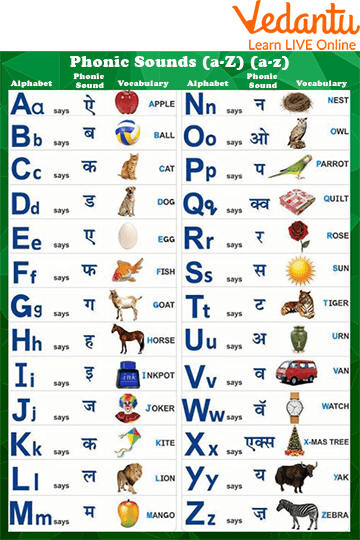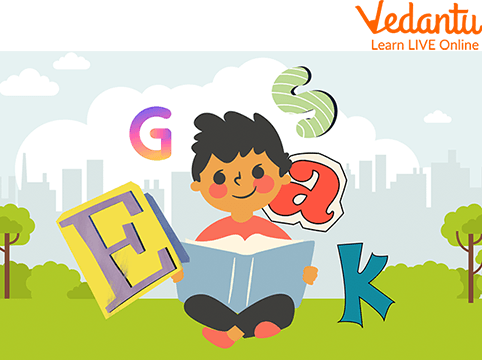




An Introduction to Phonics
Phonics can be described as the method used in which children can learn how to read and write. It aids kids with understanding, recognising, and employing the many sounds that separate one word from another in the English language. Understanding the sounds of the different letters and the way those letters sound together may help youngsters decode words as they read since written language can be compared to code. In this article, you will learn about phonics sounds chart a to z, jolly phonics sounds, and jolly phonics songs.

Phonics Sounds Chart A to Z
What is Phonics?
Reading is a remarkable activity. Among the most crucial talents learned in early childhood is this one. Even though it's obviously artificial, it plays a vital role in our daily lives. In the past, there have been many different ways to teach kids to read, but the most recent best practice research favours the use of phonics in early reading programs.
Along with phonemic awareness, vocabulary, fluency, and comprehension, phonics is one of the five components that make up reading comprehension.
Jolly Phonics
Jolly Phonics Sounds
Using synthetic phonics to teach literacy, Jolly Phonics is a playful and kid-focused method. For children, the multi-sensory approach is particularly stimulating because it includes activities for each of the 42 letter sounds. Seven groups of letter sounds total are used.
The five essential abilities for reading and writing are taught to kids using Jolly Phonics' synthetic phonics method. It provides an extensive basis for teaching literacy across three years in school and is complemented by Jolly Readers and Jolly Grammar.

Boy Enjoying Reading
The five important skills taught by jolly phonics are stated below:
learning the letter sounds,
letter formation,
blending for reading,
finding sounds in words for writing, and
tricky words
Types of Phonics
Synthetic Phonics
Words are divided up into their tiniest phonemes when teaching with synthetic phonics. In this synthetic phonics, words are divided into phonemes, the smallest units of sound, as a teaching strategy. We employ this teaching strategy to demonstrate to kids how to recognise each phoneme in a word, associate that phoneme with a letter, and effectively spell the word.
Analytical Phonics
This method, which is common in Scotland, is used to teach reading and does not pronounce the phonemes connected to specific graphemes separately. Children recognise the shared phoneme in a group of words when each word has the phoneme they are learning about. For instance, the teacher and students talk about how the words pat, park, push, and pen are similar.
Analogy Phonics
A sort of analytic phonics in which kids analyse phonic components based on the word's phonograms. A phonogram, sometimes referred to as a rime in linguistics, is made up of the vowel and all of the consonants that come after it, such as the -ake in the word cake. These phonograms are used by kids to teach them about "word families," such as cake, make, bake, and fake.
Embedded Phonics
It can be described as a method of teaching reading where phonics is just one component of a comprehensive language program. In contrast to previous methods, embedded phonics identifies the abilities to be taught strategically rather than systematically and always presents education within the context of literature.
Advantages of Teaching Phonics
Letter and sound recognition
Enables kids to sound out unfamiliar words independently
Encourages the teaching of syllable structure
It's fun
Practice Questions
1. How many phonic sounds a to z are there?
Ans: The 26 letters of the alphabet, both separately and together, stand in for the 44 English phonemes. Teaching the correspondence between sounds and the letters used to express them is a key component of phonics instruction. The 44 English phonemes can be represented by hundreds of different spelling options.
2. State the 42 sounds in Jolly phonics.
Ans: Below stated are the 42 sounds in jolly phonics:
s, a, t, i, p, n.
ck, e, h, r, m, d.
g, o, u, l, f, d.
ai, j, oa, ie, ee, or.
z, w, ng, v, oo, oo.
y, x, ch, sh, th, th.
qu, ou, oi, ue, er, ar.
3. What are jolly phonics songs?
Ans: For each of the 42 letter sounds, there are songs called "Jolly phonic Songs" that are arranged to well-known tunes. On the audio CD, youngsters sing these songs in British English. The entertaining songs and motions will make it fun for kids to learn their letter sounds. Their reading and writing will improve if they can recognise the letter sounds in words.
Conclusion
A strategy for teaching kids to read and write in an alphabetic language, like English, is called phonics. It aids kids with understanding, recognising, and employing the many sounds that separate one word from another in the English language. Children who comprehend phonics will also be better able to choose which letters to utilise when composing words.
FAQs on 42 Sounds of Jolly Phonics
1. What are consonant and vowel sounds?
When a sound is made, the airflow is either entirely or partially stopped, which results in a consonant sound. A vowel sound, on the other hand, is one in which the airflow remains unhindered at the time the sound is made. The rhythm or flow of our language is created by vowel sounds.
2. How does a kid grab language abilities?
Children interact with other kids as well as their parents and other adults in order to learn the language. All typical youngsters who are raised in typical homes and are exposed to talk will pick up the language that is being spoken there.
3. How can we assist the child who is having phonics difficulties?
There are a few areas where we should be attentive while using English in front of children.
Suggest that the youngster read each word that is written. This will support their memory of how each word sounds.
Make absolutely sure that young readers have a solid understanding of the alphabet and letter sounds.
Encourage the youngster to sound out the letters as you point them out.















